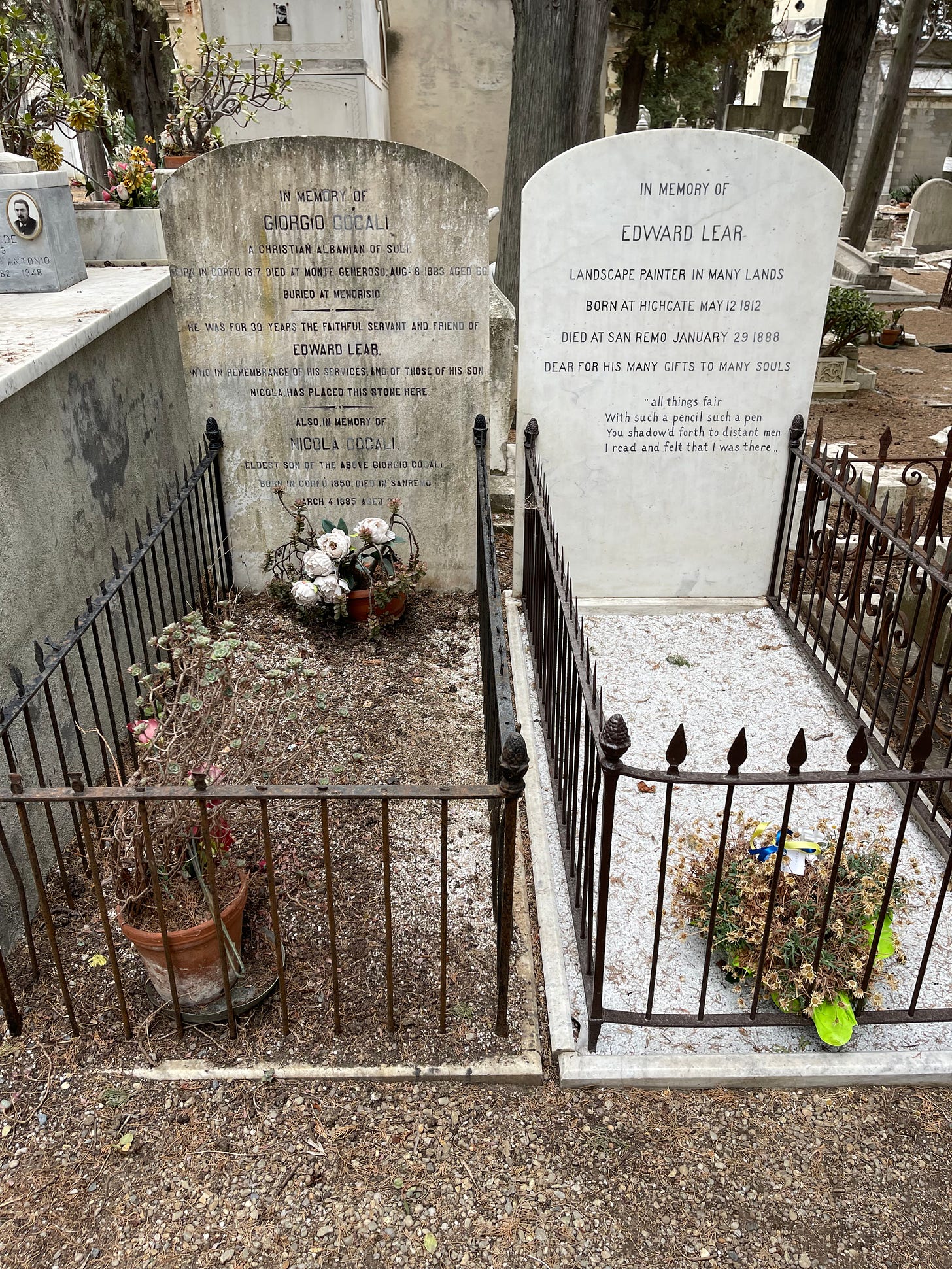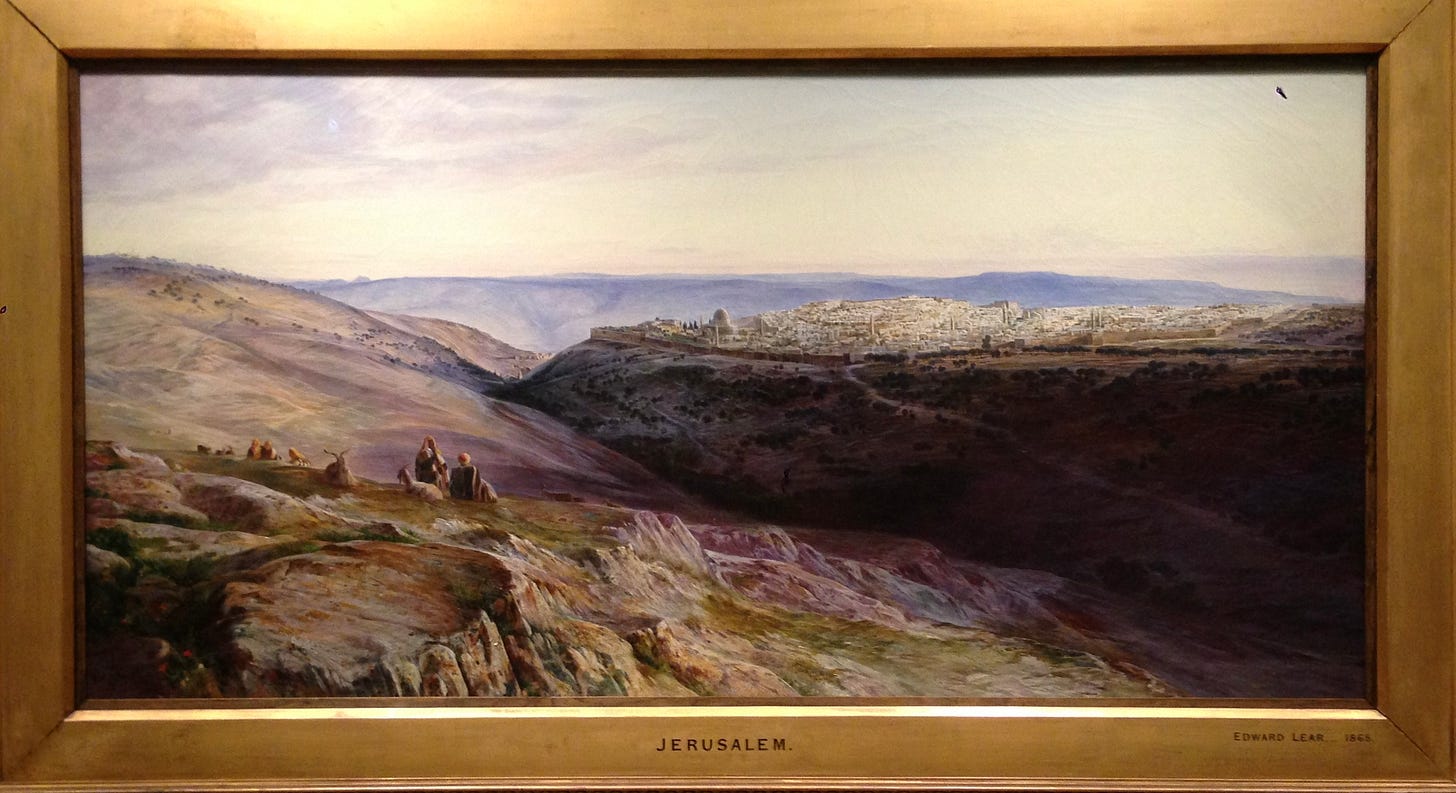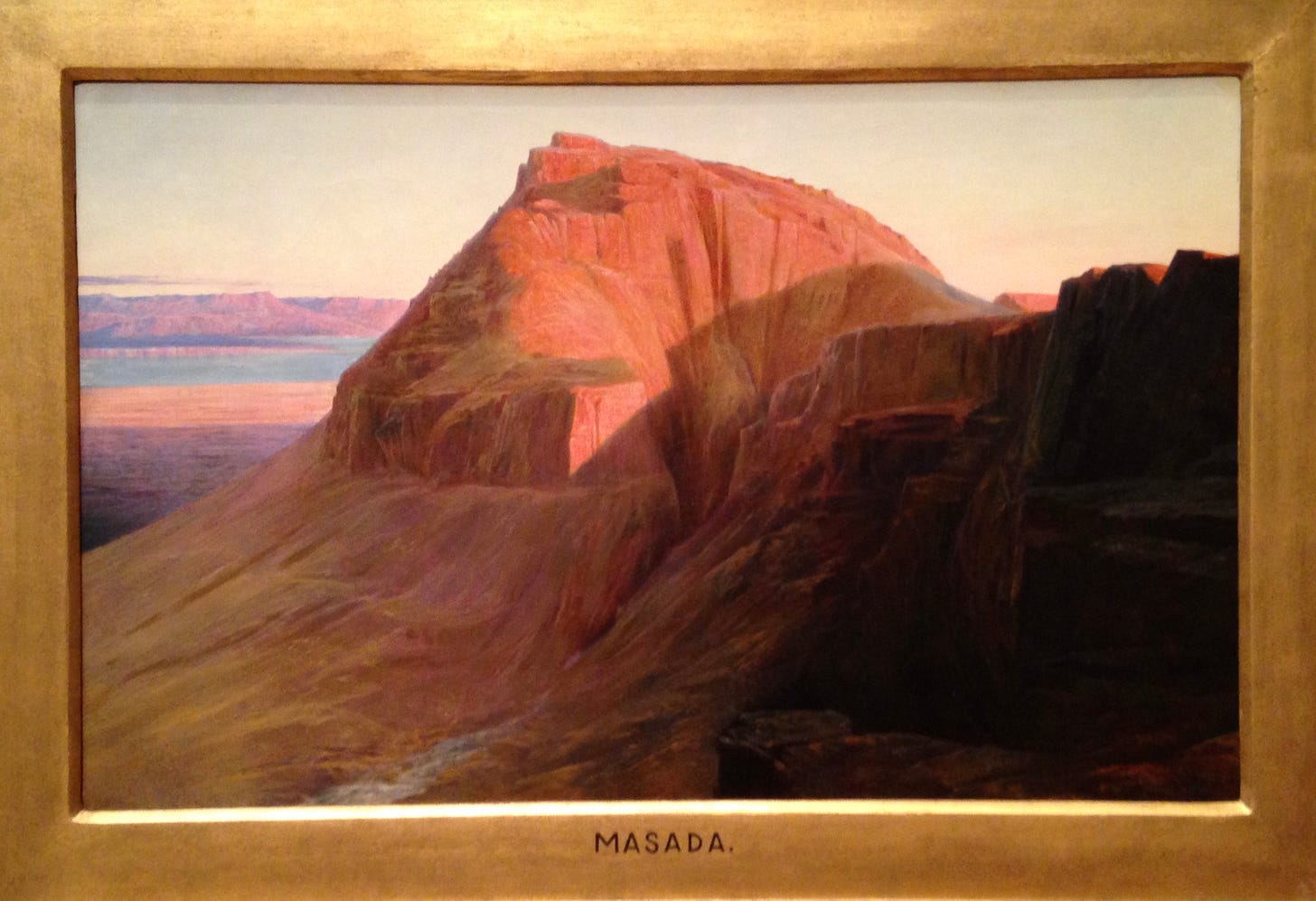The Dong arose and said;
— "What little sense I once possessed
Has quite gone out of my head!"
A constant treasure
What a delight to read Jeffrey Streeter's (@Jeffrey Streeter) recent repost of his touching tribute both to Edward Lear and to his own wanderings A constant treasure: On the road with Edward Lear.
It reminded me that in June 2022 I visited Edward Lear's grave in San Remo, Italy, at the kind suggestion and invitation of Anton Pruden and Sue Dibb, with whom we were staying at Ceriana in the hills above the town.
Lear's grave has this touching epitaph:
IN MEMORY OF
EDWARD LEAR
LANDSCAPE PAINTER IN MANY LANDS
BORN AT HIGHGATE MAY 12 1812
DIED AT SAN REMO JANUARY 29 1888
DEAR FOR HIS MANY GIFTS TO MANY SOULS
" all things fair
With such a pencil such a pen
You shadow'd forth to distant men
I read and felt that I was there "1
But even more moving is the grave that lies nestled next to Lear's like a bedfellow.
The headstone of this grave reads:
IN MEMORY OF
GIORGIO COCALI
A CHRISTIAN ALBANIAN OF SULI.
BORN IN CORFU 1817 DIED AT MONTE GENEROSU. AUG- 8 1883 AGED 66.
BURIED AT MENDRISIO
HE WAS FOR 30 YEARS THE FAITHFUL SERVANT AND FRIEND OF EDWARD LEAR.
WHO IN REMEMBRANCE OF HIS SERVICES, AND OF THOSE OF HIS SON NICOLA, HAS PLACED THIS STONE HERE
ALSO, IN MEMORY OF NICOLA COCALI
ELDEST SON OF THE ABOVE GIORGIO COCALI BORN IN CORFU 1850 DIED IN SANREMO
MARCH 4.1885 AGED 34
For my sixth or seventh birthday, my godmother, who had the wonderful name Nancy Greenwood, gave me a copy of The Complete Nonsense of Edward Lear. That present set me off on the eternal quest to be a poet, and triggered my love of nonsense and playing with sounds. The 'Dong with a luminous nose' is certainly one of my muses.2
As an adult, I learnt just what an amazing painter Lear was too. In the Ashmolean, Oxford, I came across his landscape of Jerusalem.
Edward Lear (1812-1888)
Jerusalem oil on canvas
Signed in monogram and dated, EL 1865
Lear visited Palestine in 1858, and spent a fortnight making careful studies of Jerusalem from the surrounding hills. These formed the basis for five paintings, of which this is the largest and most magnificent. It was made for Samuel Price Edwards, a close friend of the artist, on his retirement from the Customs at Liverpool in 1865. The view is dominated by the Temple Mount with the Dome of the Rock, and the Mount of Olives to the left.
(Accepted by H.M. Government in lieu of Inheritance Tax on the estates of Captain and Mrs L.E.D. Walthall and allocated to the Ashmolean Museum, 2006)3
And in the Palace of the Legion of Honor in San Francisco another of his paintings, this time of Masada on the Dead Sea.
Edward Lear
British, 1812-1888
Masada (or Sebbeh) on the Dead Sea,
1858
Oil on canvas
Masada was a fortress on an isolated mountain looming above the Dead Sea to the east and a formidable desert to the west. Historical accounts relate that Masada became an armed Jewish camp in revolt against Rome in A.D. 66, and the Tenth Roman Legion laid siege to the fortress in A.D.
72-73. Atter Roman battering rams breached the gates, the defending group of 967 chose to commit suicide rather than submit to capture and imprisonment.
Influenced by the style and ideas of the Pre-Raphaelite Brotherhood, Masada is both a topographical record and a symbol. Lear dramatically conveys the effect of searing heat on the arid landscape by contrasting sunlight, deep shadow, and vivid hues on the distant horizon. At the same time, the site's tragic history permeates the image. The artist has achieved a perfect balance between a meticulous rendering of a specific place and an enduring symbol of the human spirit's indomitable struggle for freedom.
(Museum purchase, Grover A. Magnin Bequest Fund, The Fine Arts Museums of San Francisco.)4
The natural history of Edward Lear
There's an intriguing article by Steven Leech, assistant Curator of Science at National Museums Liverpool on the Museums’ website, where he considers both Lear’s tremendous talents but also discusses his sexuality.
Getting to know Edward Lear... on his own terms
Leech highlights Lear’s remarkable talent for painting animals from life
…that brought Lear to the attention of Lord Stanley, who would later become the 13th Earl of Derby. The Earl became Lear’s greatest support and patron. Lear was commissioned to paint the live (and dead) zoological specimens amassed at Knowsley Hall in Liverpool.
And I love this idea…
Lear’s interest in the natural sciences inspired him to play with the very idea of categories. In his Nonsense Botany (1877), Lear created illustrations of unbelievable flora which poked fun at the long tradition in the natural sciences to identify new species with long Latin names… His drawings might also be read as a challenge to the Western tradition of collecting and categorising the world around us.
Lear’s nonsense often make lots of sense…
Edward Lear's story also has contemporary resonance. His life and work reveal something of his (often unrequited) love of other men and his penchant for pushing boundaries through lively language and absurd imagery.
As is often the case with Lear, however, there is more than meets the eye. Throughout his life, Lear was seen as a figure of fun (and his sense of silliness did make him stand out in the social circles he moved in). However, Lear often felt different and somewhat apart from the people around him. In letters to his friends, he described episodes of this social anxiety as "the darks". Lear was epileptic, which he kept secret from even his closest confidants. He also had a number of unrealised romantic attachments to other men.
We don't know how Lear understood his own sexuality or whether he was ever open with others about it. But in this light, the genderless and unlikely pairing of the owl and pussycat might take on new meanings. His sense of being different can also be read in his poems through references to a judgmental 'they', anonymous people who seek to squash any behaviours beyond the apparent norm. Our dancing old man of Whitehaven, for example, is "smashed" for his indiscretions.
What’s the plan?
Jeffrey Streeter’s musings on his travels – 'What was the plan and what did it all add up to?' – alongside The Honest Broker's (@tedgioia) article Harrison Ford and the Origin of Western Civilization also got me thinking about homelessness and homecoming, but more of that in another post.
I'm away on holiday in Japan so expect some irregular posts from my travels in this wonderful land. In the meantime I've scheduled regular updates from my New & Selected section and serialised episodes of my historical detective story The Reward of Delay. All comments welcome. And expect another mise en abyme post very soon!
Leaving you with a short sequence from the Korea pavilion at Osaka Expo 2025.
Not a bad description of Jeffrey Streeter’s writing either.
When awful darkness and silence reign
Over the great Gromboolian plain,
Through the long, long wintry nights; —
When the angry breakers roar
As they beat on the rocky shore; —
When Storm-clouds brood on the towering heights
Of the Hills of the Chankly Bore: —
Then, through the vast and gloomy dark,
There moves what seems a fiery spark,
A lonely spark with silvery rays
Piercing the coal-black night, —
A Meteor strange and bright: —
Hither and thither the vision strays,
A single lurid light.
Slowly it wander, — pauses, — creeps, —
Anon it sparkles, — flashes and leaps;
And ever as onward it gleaming goes
A light on the Bong-tree stems it throws.
And those who watch at that midnight hour
From Hall or Terrace, or lofty Tower,
Cry, as the wild light passes along, —
"The Dong! — the Dong!
"The wandering Dong through the forest goes!
"The Dong! the Dong!
"The Dong with a luminous Nose!"
From The Dong with a Luminous Nose by Edward lear
From the Ashmolean interpretation panel about Lear’s painting.
From the interpretation panel in the Legion of Honor.










A beautiful drift between Shakespeare and sky-gazing. You captured the strange ache of a day where nothing happens—and yet everything feels heavy.
An interesting glimpse into lear's life as an artist. And thank you for the kind mention, John! I hope you're enjoying Western Japan.